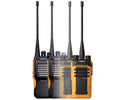
The Benefits of Upgrading From Analog to Digital Radios
, by Joseph Gabriel, 5 min reading time

, by Joseph Gabriel, 5 min reading time

Technology seems to advance faster every year, and analog radios are quickly becoming obsolete. However, despite that, many businesses and workplaces are hesitant to upgrade to digital. Rather than considering how digital radios could improve things, they often get stuck on the many ways switching to digital may interrupt their daily workflow or cause other complications. Allow us to show you the benefits of upgrading from analog to digital radios so you can make a more informed decision.
The most significant benefit of digital is that a radio’s coverage and range are vastly superior to analog. Unlike analog radios, which rely on one continuous radio signal that weakens as it travels, digital radios convert your message into a digital format that will remain strong right up to the ends of the radio’s transmission range. This eliminates the need for extra equipment like repeaters that boost analog signals by capturing and re-transmitting them.
Furthermore, digital radios are more resilient to interference, such as concrete walls, that may otherwise block analog radios from communicating with one another.
A major restriction of analog radios is that a single conversation would dominate an entire channel, meaning that if you needed to speak to someone else, you’d have to switch channels and communicate that switch to them. Digital radios, on the other hand, can host multiple conversations between two or more people. While multiple conversations can occur on the same channel, you can still maintain privacy and security without worrying that someone may be listening in or causing interference.
Analog radios will always pick up any sound around them, whether it be your voice or something happening in the background. This can make things incredibly difficult when you’re trying to communicate in a noisy environment. Digital radios, on the other hand, can selectively mute background noises so that only your voice gets carried over to any receiving radios.
One of the best benefits of upgrading from analog to digital radios is that the software on digital radios can be continually updated. This keeps the digital radios you buy more relevant for much longer as new features become available, and the operating system remains efficient and supported by the manufacturer. In contrast, with analog radios, you must buy a whole new radio to get the latest features and upgrades.
With the addition of digital features, radios have become multifaceted devices. For instance, emergency functions, such as the “lone user” safety alert, will send an alarm to crew leaders when a worker is in danger or has gotten injured. Likewise, a one-touch emergency button is available to instantly notify crews that something has gone wrong and emergency response is necessary.
Digital radios have also improved functionality basics – such as the batteries! These radios typically have extended battery lifespans because both the battery and the radio are more efficient in using energy. For example, Motorola has long been at the forefront of two-way radio innovation, so you can expect Motorola batteries to be long-lasting with a greater energy capacity.
As we’ve touched upon, digital radios provide enhanced security and privacy while allowing multiple conversations to occur on the same channel. The key to this is that digital radios encrypt your message without degrading the quality of your voice. There are also privacy codes that ensure only the people you invite can access your conversation on a channel, eliminating the risk of someone listening in on confidential discussions.
One of the best features of digital radios is their ability to integrate with existing analog radio systems seamlessly. This is significant because many businesses are hesitant about the cost of upgrading their entire organization’s radios, but since digital radios can communicate with analog radios, you can upgrade gradually. This lessens the financial burden of upgrading to digital, and you can focus on improving the most critical parts of your system first.
While digital radios don’t often necessitate the need for accessories like repeaters, don’t think that there aren’t other accessories for you to take advantage of. For instance, programming cables allow you to customize your radio’s settings to optimize performance. Naturally, not many people will be familiar with programming radios, so there are pre-made programs you can download onto your devices. These optimizations can focus on the aspects you value most – such as maximizing the radio’s range for long-distance communication or conserving energy for prolonged use.
Other accessories include shoulder-mounted microphones or earpieces for hands-free communication. This can be an excellent investment for industries like construction, where workers must use both hands while communicating with their team.
And, of course, you can always purchase extra batteries if needed. Having a surplus of batteries will allow you to use your radio without worrying about running out of power.
Upgrading your radios to digital is an investment that will help grow your business and cover your communication needs for years to come. The ability of digital models to communicate with analog models makes the investment much more feasible for a company, ensuring that the initial cost is not a dealbreaker but still allowing you to save money in the long run by investing in these long-lasting, software-based radios.
For all your two-way radio needs, you can depend on Atlantic Radio Communications. Not only are we experts when it comes to two-way radios, but we also supply various models and radio accessories from only the most trusted brands. If you’re feeling overwhelmed while trying to consider what’s best for your business, contact us for assistance! We’d be more than happy to provide you with further information and make recommendations based on your company’s needs. Shop with us today and see the difference for yourself!
